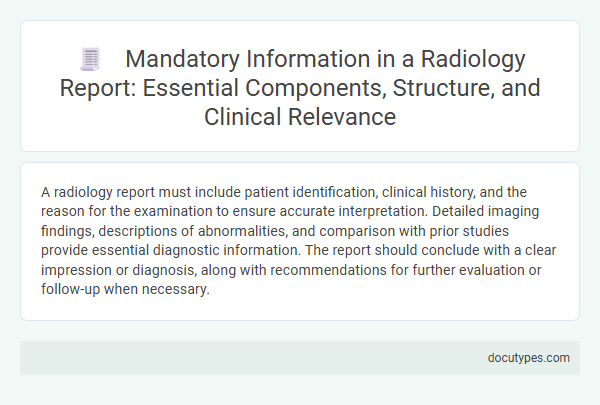A radiology report must include patient identification, clinical history, and the reason for the examination to ensure accurate interpretation. Detailed imaging findings, descriptions of abnormalities, and comparison with prior studies provide essential diagnostic information. The report should conclude with a clear impression or diagnosis, along with recommendations for further evaluation or follow-up when necessary.
Introduction to Radiology Reports
A radiology report is a critical document that communicates the findings of medical imaging studies to healthcare providers. It must include essential information such as patient identification, the type of imaging modality used, clinical indications, and detailed observations. Clear and accurate reporting ensures effective diagnosis and guides appropriate patient management.
Importance of Mandatory Information
| Mandatory Information | Importance |
|---|---|
| Patient Identification | Ensures the radiology report is accurately linked to the correct individual, preventing medical errors and facilitating proper patient care. |
| Clinical History | Provides context for interpreting imaging results, helping radiologists identify relevant abnormalities and tailor their findings to the patient's condition. |
| Examination Details | Includes the type of imaging performed, date, and technique used, which are essential for reproducibility and comparison with previous exams. |
| Findings | Describes the imaging observations accurately, allowing your healthcare provider to make informed decisions regarding diagnosis and treatment. |
| Impressions or Conclusions | Summarizes critical radiologic insights, offering a clear and concise interpretation that guides clinical management. |
| Signature of Radiologist | Confirms the authenticity and accountability of the report, ensuring it meets professional standards and legal requirements. |
Essential Patient Demographics
Essential patient demographics are a mandatory component of any radiology report. These details ensure accurate identification and proper correlation with clinical history.
Your radiology report must include the patient's full name, date of birth, and unique identification number. This information helps avoid errors and supports effective communication between healthcare providers.
Clinical History and Indication
What information is mandatory regarding clinical history in a radiology report? Clinical history provides essential context for interpreting imaging findings and guides the radiologist's diagnostic approach. Including detailed clinical history ensures accurate correlation between imaging results and the patient's symptoms or medical background.
Why is the indication important in a radiology report? The indication specifies the clinical reason for performing the imaging study, helping to focus the analysis on relevant pathology. Clear documentation of the indication supports the justification of the procedure and aids in clinical decision-making.
Imaging Technique Documentation
Imaging technique documentation in a radiology report must include the specific modality used, such as MRI, CT, or X-ray. Details about the imaging parameters, including contrast administration, slice thickness, and scan sequences, are essential. Clear documentation ensures accurate interpretation and facilitates effective clinical decision-making.
Findings and Observations
A radiology report must clearly detail all significant findings and observations to ensure accurate diagnosis and effective treatment planning. Precise descriptions of abnormalities, measurements, and the location of lesions or pathological changes are essential components.
Your healthcare provider relies on these findings to assess your condition accurately. Including relevant comparisons to previous studies and noting any incidental observations helps create a comprehensive clinical picture.
Impression and Differential Diagnosis
A radiology report must include a clear and concise Impression that summarizes key findings relevant to the clinical question. The Differential Diagnosis section provides potential alternative diagnoses based on imaging features and clinical context.
The Impression guides referring physicians in decision-making by highlighting the primary diagnosis or abnormality. Differential Diagnosis aids in narrowing down possible conditions and suggests further diagnostic steps if needed.
- Impression - A focused summary of the most critical imaging findings, directly addressing the clinical indication for the study.
- Differential Diagnosis - A list of plausible alternative diagnoses that explains the imaging features observed in the report.
- Clinical Relevance - Both Impression and Differential Diagnosis must correlate with patient history and clinical presentation to enhance diagnostic accuracy.
Recommendations and Follow-Up
Recommendations in a radiology report must clearly guide the referring physician on the next steps, whether additional imaging or clinical evaluation is necessary. Follow-up instructions are crucial for monitoring disease progression or response to treatment.
Clear documentation of recommendations ensures timely and appropriate patient management, reducing the risk of diagnostic errors. Follow-up details should specify the type and timing of subsequent studies or clinical assessments. Inclusion of standardized terminology enhances communication among multidisciplinary teams.
Structured Reporting Formats
Structured reporting formats in radiology ensure that your radiology reports contain all essential information in a clear and consistent manner. These formats improve communication between radiologists and referring physicians by standardizing report content.
- Patient Identification - Includes the patient's name, date of birth, and unique medical record number to ensure accurate tracking.
- Clinical History and Indication - Describes the reason for the exam and relevant clinical background to guide interpretation.
- Findings and Impressions - Detailed description of observations and a concise diagnostic conclusion for clinical decision-making.
Using structured reporting formats optimizes the clarity and completeness of radiology documentation for better patient care.
What Information Is Mandatory in a Radiology Report? Infographic

